
The beautiful sandy beaches, coastal coves, and white-washed villages are what make legendary vacations. If it’s your first time here, it can be overwhelming. Covering multiple seas and thousands of islands, planning a Greek island hopping trip isn’t as straightforward without some research, especially if you plan on island hopping. This Greek Islands travel guide is a must-read for anyone heading there soon, there is also useful information that will be helpful to discover the best Greek Islands to visit for the first time
Let’s dig into the practical things you might already be making plans for, suggest a few things you may not have already thought of, and let’s delve deeper.
TOP TIPS FOR THE GREEK ISLANDS
The Best Greek Islands Travel Guide

This Greek Islands travel guide will primarily focus on The Cyclades Islands, but it will also have information relevant for those planning trips to the whole Greek Archipelago, which spans 6,000 islands and takes up 7,500 km of the country’s 16,000 km coastline.
WHAT YOU NEED TO KNOW
- Electricity – 230 volts, 50Hz

- Currency – Euros (EUR)
- 1€ EUR = $1.11 USD = $1.45 CAD
- ATMs can be found all over and the credit cards are widely accepted
- SIM card – The three main companies in Greece are COSMOTE, Vodafone, and WIND. All companies have some sort of pre-paid package available. Some are more aggressive about promoting in Athens with street stands but others you have to visit a shop for. As an example, Vodafone offers 9.2GB for 20 EUR or 4GB for 10 EUR on top of minutes.
- Alternative data options – Airalo is what we used in Greece because eSIMs are so easy nowadays. Make sure to use our code WILLIA9500 to save $3 USD.
- Measurement system – Metric
- Tipping – Not a strong culture of tipping but is expected in the service industry. In general 10% is the rule of thumb.
- Language – The official language is Greek.
Greek Islands geography
There are at least 6,000 islands in Greece scattered throughout two different seas. To grasp how wide it spans, you need to know the breakdown of these islands and the clusters that form this stunning archipelago.
In this free Greece travel guide we break it down between the two seas that are involved: Aegean and Ionian.
In the image below the boxes give you an idea of some of a few of the clusters of islands that you can visit in Greece.
Aegean Sea
The Northeastern Aegean Islands – Agios Efstratios, Thasos, Ikaria, Lesbos, Limnos, Inouses, Samos, Samothrace, Chios, Psara.
The Sporades Islands – Alonissos, Skiathos, Skopelos, Skyros.
Evia – The island of Evia is the second largest Greek island after Crete and is also known by its ancient name of Euboea. Its close proximity to Athens on mainland Greece makes it a popular destination for the residents of Athens. It is bordered by the region of Viotia, (latinized as Boeotia or Beotia) to the east, with the south touching the Aegean Sea, before spreading into the Evian Gulf.
Islands of Argosaronic – Angistri, Aegena, Methana, Poros, Salamina, Spetses, Hydra.
The Cyclades – By far the largest island group with a total of 56 islands, the most important ones being Andros, Antiparos, Delos, Ios, Milos, Mykonos, Naxos, Paros, Santorini, Syros, Folegandros and several others, as well as the ‘Minor Cyclades’ comprising Donousa, Irakleia, Koufonisia and Schinousa.
The Dodecanese – Astypalaia, Kalymnos, Karpathos, Kasos, Kastellorizo, Kos, Lipsi, Leros, Nisyros, Patmos, Rhodes, Symi, Tilos, Chalki.
Crete – Crete is the largest of the Greek islands and is divided into four prefectures: Chania, Rethymno, Heraklion and Lasithi.
Ionian Sea
The Ionian Sea is to the west of mainland Greece, and while they may not be as famous as the ones in the Aegean Sea, they are equally beautiful and are often visited more by the local Greeks.
The Ionian Islands – Zakynthos, Ithaca, Corfu, Kefalonia, Lefkada, Paxi, and Kythira
From here, it breaks down into smaller islands – Antipaxi, Ereikoussa, Kalamos, Kastos, Mathraki, Meganissi, Othoni, Skorpios, and Strofades.
The others
There are a few groups of smaller islands that don’t really belong anywhere, including the islands of Gavdos (situated south of Crete), Elafonissos (in the Gulf of Laconia), and Trizonis (in the Gulf of Corinth).
Which islands to visit
How do you choose which is the “best Greek island to visit”? We wanted to start with a few baseline itineraries. First we checked out the Greece travel itineraries of G Adventures and Intrepid Travel to get a few ideas to form our own Greek Islands travel guide.
To help you through that thought process we broke down how we ended up here in our 14 day Greece island hopping itinerary:
- Decide which sea you want to do – Ionian or Aegean?
- For a trip spanning 2 weeks, pick a cluster to focus on. Jumping between island groups makes ferries complicated, distances long, and time wasted. You want to optimize the time you have with minimal transport so you can spend precious time exploring and soaking up the islands.
- If there’s a specific island you want to visit, for instance Santorini, skip steps #1 and #2. It also helps to know whether Santorini is worth visiting, read that alongside this Greek Islands travel guide.
- Divide your number of trip days by 3. That’s how many islands to visit without rushing your way through. For example on our 14 day trip we could only fit in 4 islands comfortably. You could try to fit in more if you were really ambitious. Our guide how many days in Santorini you need should help give you an idea of how to gauge your time in each place.
- Research blog posts and look at photos. Here, we committed to visiting 2 popular islands and 2 lesser known ones of Greece.
With this guide and content created for your Greece travel, we hope it’ll make your trip planning easier.
BEFORE YOU CONTINUE
You need to read the the full 14 day Greek island hopping itinerary to get an idea of how to plan and choose the right islands in the Western Cyclades. Read that after this Greek Islands travel guide.
Getting there

For our trip, we focused on how to get from Athens to Santorini, but for a more general look, you should learn about flying vs. ferry.
Flying in

Greece’s primary international airport is Athens Eleftherios Venizelos International Airport (ATH). It’s your main way in and out of the country coming from an international destination.
As the capital of Greece, flying into Athens makes sense. If it’s your first time you should make some time to explore the city. It is also home to the ports that will take you down to the Western Cyclades area of the Greek Islands.
Not all islands have airports, but the larger ones do, including Santorini, Mykonos, Naxos and a few more. So if you can fly into these airports easily you can start your trip from one of these before moving onto your next destination.
There are direct flights to Santorini! From Europe you can grab one from Thessaloniki, Naples, Rome, Venice, Milan, Barcelona, Prague, Frankfurt, Paris, Amsterdam, and London.
Once in Greece, the main national carriers are Aegean and Olympic Air. RyanAir is a discount carrier that also services Athens and Santorini. We recommend using Skyscanner or the Skyscanner app to find the best prices on flight tickets.
When visiting the Greek Islands, you’ll likely fly in via Athens. If time is tight and cost is no issue, fly into Santorini and then fly out of another island with an airport. Then you’ll likely be taking ferries in between the islands.
Ferry

The primary way to get around to the Greek Islands is by ferry. It’s not the fastest, but they run frequently, and they hit islands you can’t fly to. They also do run somewhat on time so you can plan your travel between islands fairly accurately.
Traditionally, visiting the Greek Islands means starting in Athens and island hopping with ferries exclusively. This is the most cost-effective method but takes time because the trip from Athens to any island is usually going to be your longest leg. Ferries function like buses and stop at multiple islands, they’re usually on time but delays and cancellations can sometimes happen.
Ferry companies
There are a number of ferry companies out there that operate between the islands and the mainland. The main ones that are relevant for The Cyclades are Blue Star Ferries, SeaJets, Golden Star Ferries, Hellenic Seaways and Aegean Speedlines. For the rest you can find out more information here.
Ferry itinerary
When planning your island hopping itinerary, using a tool like Ferries in Greece makes things easier. We dub this tool the “Skyscanner of ferries.” You can basically enter in the itinerary as you would a flight search tool, and it’ll give options and prices to choose from.
Use this Ferry Planning Tool
FerryHopper allows you to find out what ferry companies are operating to and from Santorini. We recommend using this to help with trip planning.
WHAT YOU NEED TO KNOW
FAQ:
- Are there any discounts? – We found that if you aren’t a local or able to take advantage of a large pass, there weren’t any codes or promotions to take advantage of but it never hurts to check.
- Can you save money staying with one ferry line? – Even if you do a multi-leg journey, there are no discounts or reasons to use one particular line but you can also jump around between different companies. You don’t need to stick to one.
- Is there a point in waiting to book ferries? – Only if you’re still unsure of your plan. Once you have that there’s no point in waiting. Ferry prices don’t drop if you book last minute and you don’t want your specific route to sell out, which in peak seasons can easily happen well in advance. Make sure to use Ferries in Greece to get organized as soon as you have your plans confirmed.
Getting the ferry from Athens: Piraeus vs. Rafina
In Athens there are two ports:
Rafina
- Located to the east of Athens
- Closest to the city center of the two ports
- There is a convenient direct bus from Athens Airport
- Takes 30-40 minutes to get here from Athens Airport by bus
- No metro options to get to Rafina
- Fewer ferries run from this port
- Bus from the airport costs 4 EUR
Piraeus
- Located to the south west of Athens
- Primary port from Athens
- There are more ferry route options that operate from here
- Various different options to get to Piraeus (bus, bus + metro, metro)
- Takes one to 1.5 hours to get here from Athens Airport by bus
- Bus from the airport costs 6 EUR
Taking the bus from Rafina
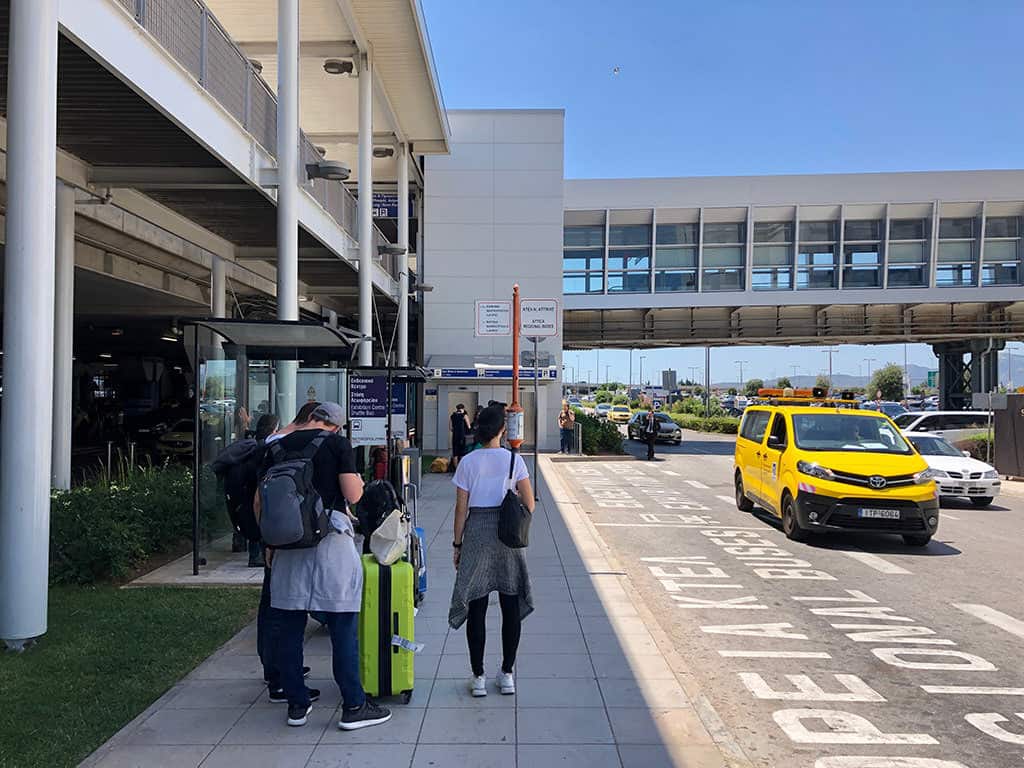

The Rafina bus is privately-run and the location isn’t where you may expect compared to the bus to Piraeus. The bus is located right across from the Mitsis Hotel at the airport, between Exits 2 and 3 where you’ll first cross the street.
The bus schedule can be found here. Note that this bus is not 24 hours, so check the schedule based on your flights. Credit card is accepted for booking.
Taking the bus from Piraeus
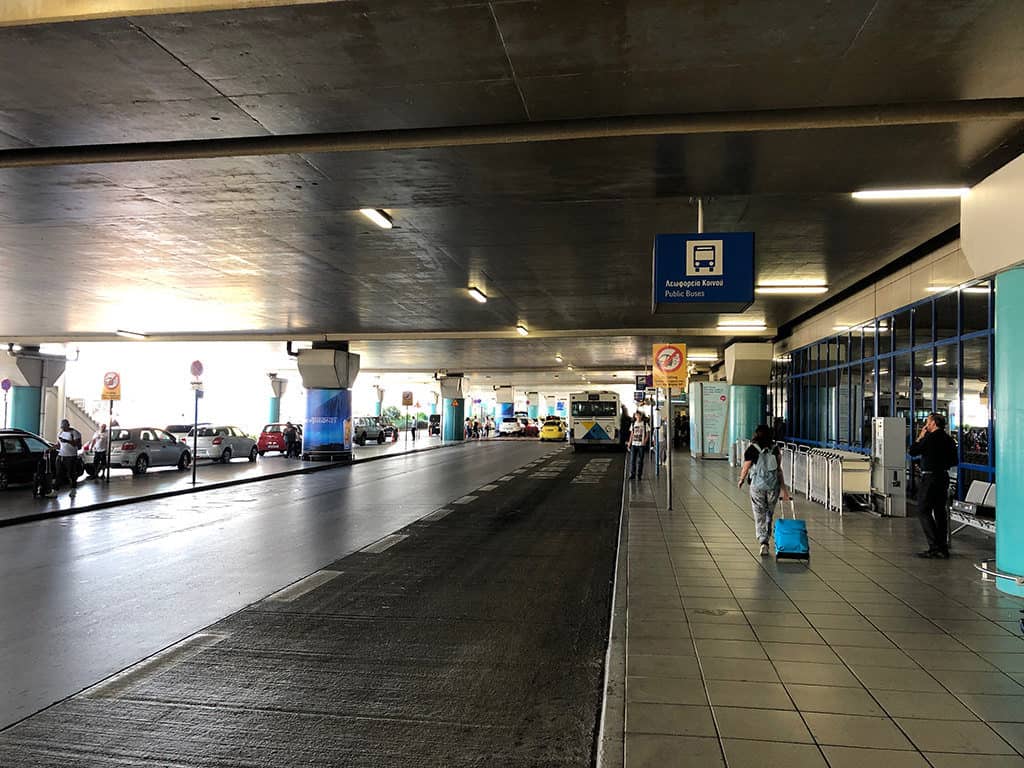

If you’re headed to Piraeus, look for public bus number X96. The ride is about an hour and the full schedule is here. This bus runs 24 hours.
Note that public buses on the arrival level are easy to find because all signs for public transportation will point you that way.
You can purchase your tickets at the booth and you are also able to pay by credit card.
Boarding and disembarking ferries
Every ferry company is slightly different because each ship is constructed and run differently. But there are general similarities that you can expect from boarding to disembarking.

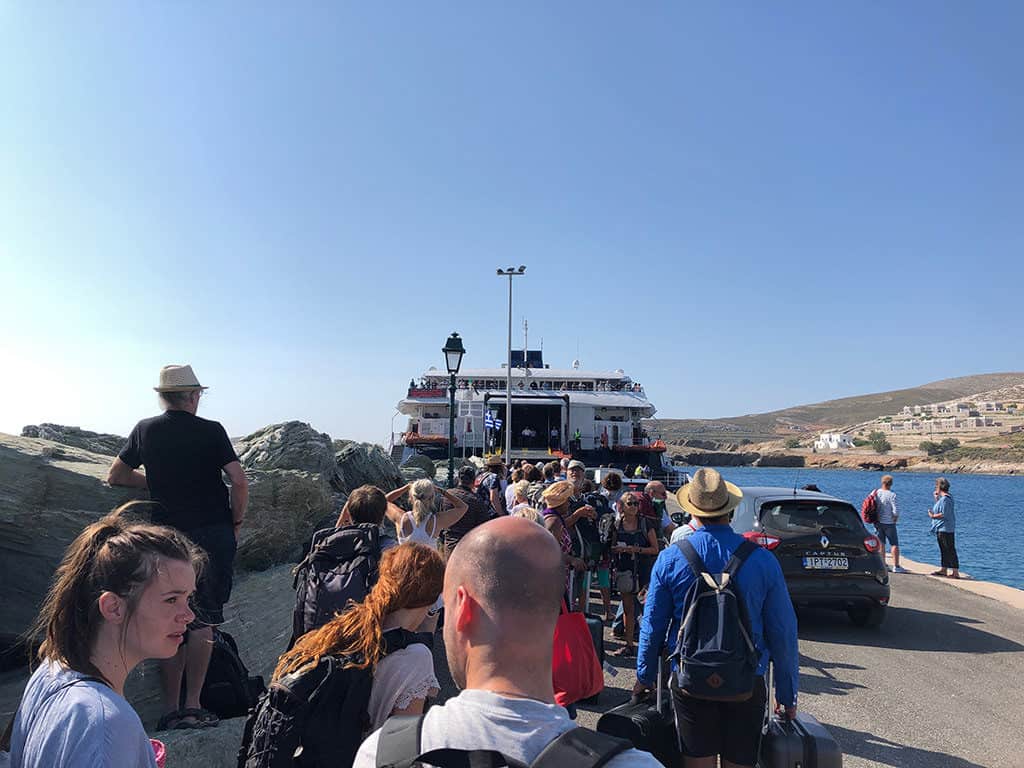
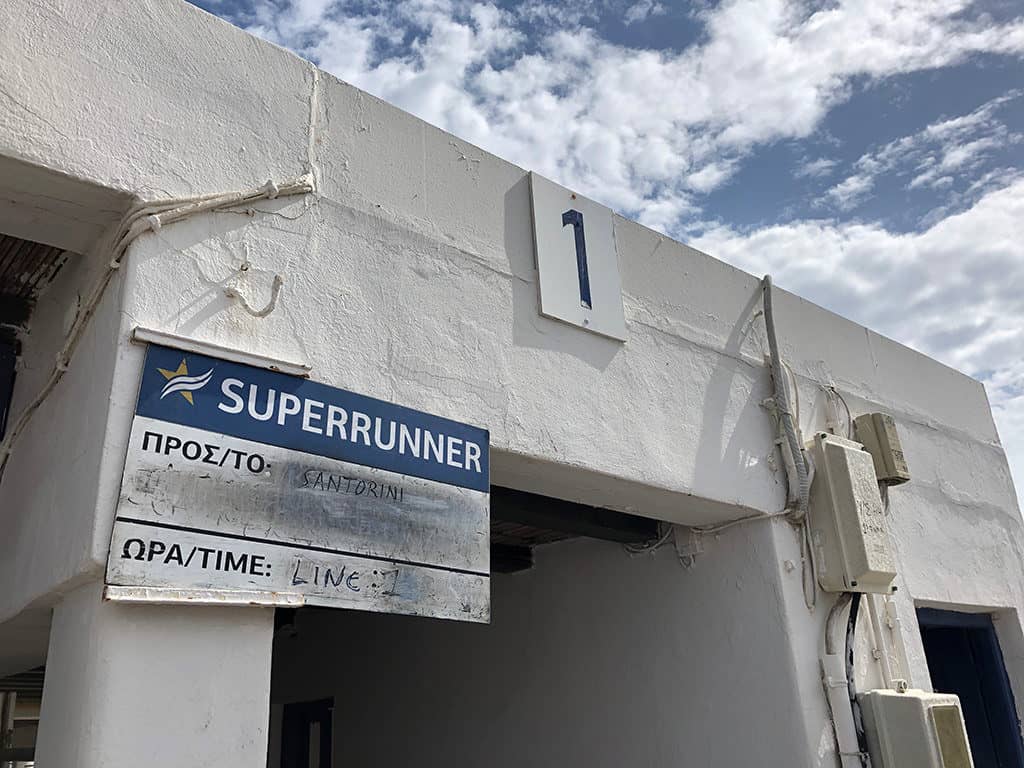
On most islands there is a waiting area at the port where they have divided columns. Sometimes they’re labeled with the right ferry route and times but usually it’s not that organized. If in doubt, ask other people if you’re in the right place. Some waiting areas are just an open lounge and someone will yell out the next ferry when it comes in. Sometimes there’s no covered waiting area at all and you just find a random place to sit. This is all part of the charm of Greek island hopping!
As the boat arrives, everyone seems to automatically know to start a queue and the attendant lets you know when it is your turn to board.

Boarding – Once the ramp is down, cars and passengers that are arriving at the port exit first. Then they’ll call everyone waiting to board to walk up the ramp and put your luggage on the racks available in the cargo/car hold. There’ll be stairs on the left and right heading up to the main deck of the ship and there’ll be someone scanning tickets there. After that, head up and grab a seat or watch the action from the open rear of the ship.

Disembarking – When the ferry is close to the destination port, they’ll make an announcement for everyone to gather in the cargo hold. You’ll then head back downstairs and grab your luggage. Once the ramp drops down, the crew will be yelling and ushering for everyone to quickly get off. So make sure you are organized and move fast!
About Piraeus
The boarding process is a little different in Piraeus because of its massive size and all of the unloading is done on arrival so they’re waiting for you to board. There’s no luggage held down below. Instead, you bring your luggage to the cabin and store it in shelving areas. These are relatively safe but we recommend dropping by your cabin when the boats start docking to make sure nobody takes their chances during disembarking.
Your ferry ticket will have a specific gate you need to go to so account for time to figure out where that is. If you take a look at the map below, the subway is closest to E5 and E6.

WHAT YOU NEED TO KNOW
- Gate E1 – Ferries for Dodecanese Islands (Rhodes, Kos, Kastelorizo, Kos etc) – Blue Star Ferries / Superfast Ferries
- Gate E2 – Ferries for North Aegean Islands (Lesvos, Chios, Samos) (Blue Star Ferries & Hellenic Seaways)
- Gate E3 – Ferries for Crete. (Minoan, Anek, and Blue Star Ferries)
- Gate E4 – Ferries for Crete and other small islands such as V.Kornaros and Prevelis
- Gate E5-E6 – Blue Star Ferries for Cyclades
- Gate E7 – Speedrunner, Highspeed 4& 6, and Nissos Mykonos
- Gate E8 – Ferries for Saronic Islands, catamarans and hydrofoils
- Gate E9 – SeaJets and Zante Ferries (E10 is the exit, E9 is the entrance)
- Gate E11 & Gate E12 – Cruise ships gates, only for passengers of the cruise ships.
Onboard experience
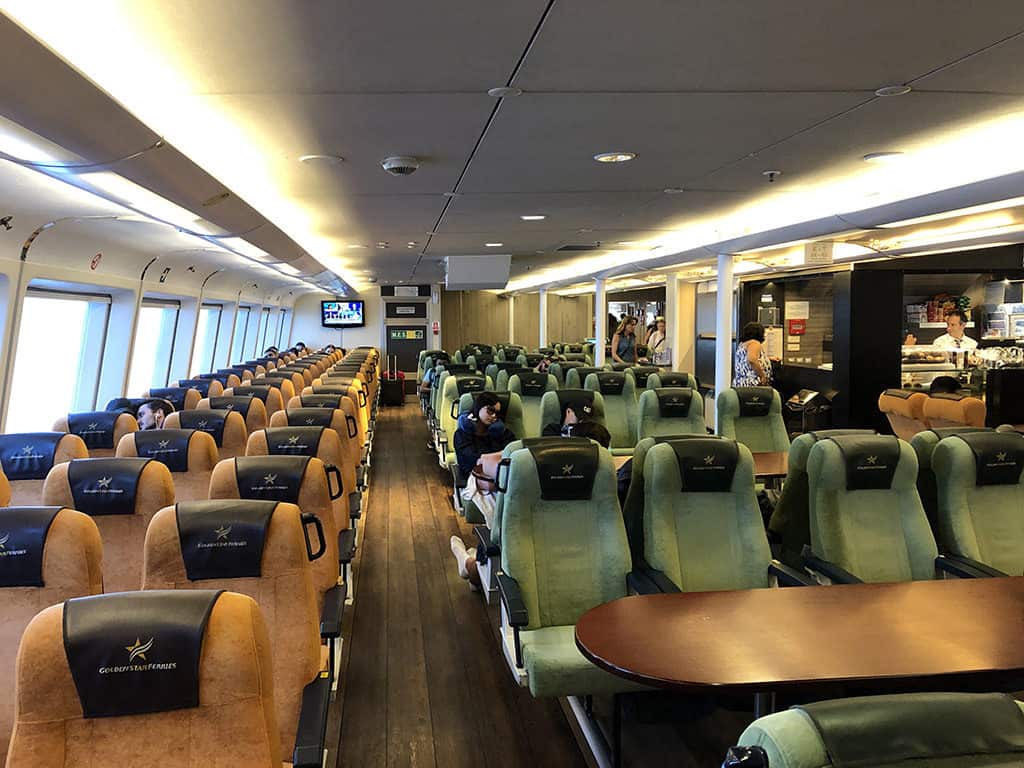
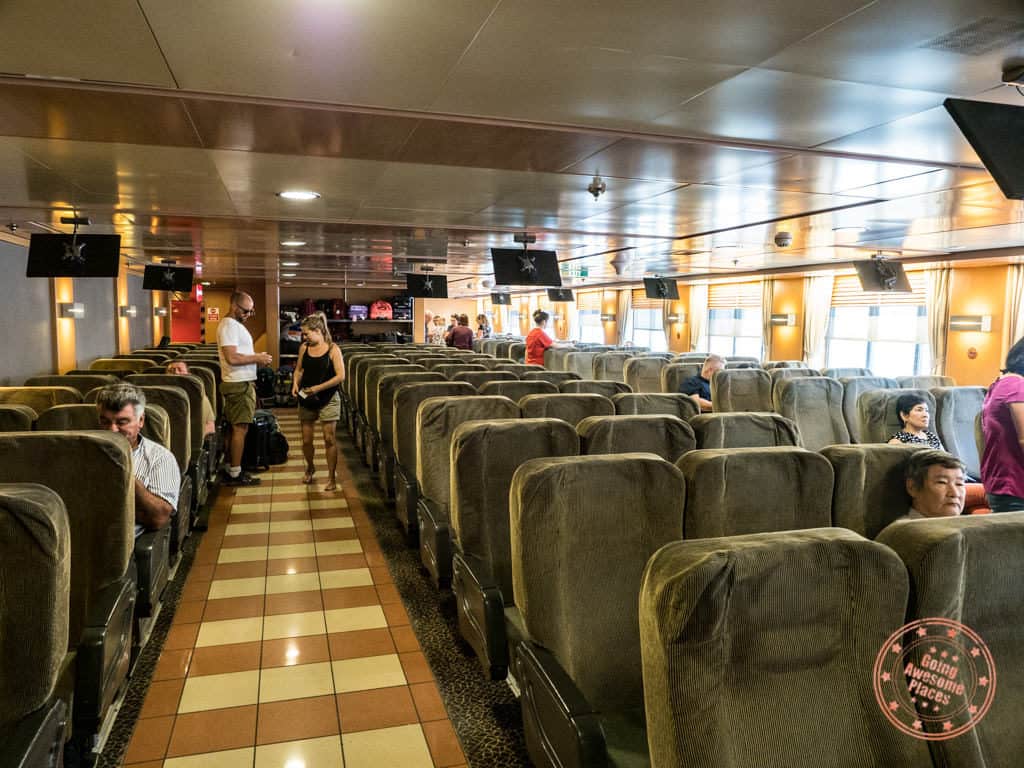
- Food onboard – There’s a couple of cafes that serve the basics like sandwiches, pastries, drinks etc.

- Bringing food onboard – They didn’t seem strict on outside food at all so feel free to bring your own picnic.
- Assigned seats – Seats are automatically assigned with ticket purchase. For the less-crowded inter-island ferries, nobody checks your tickets for your assigned seats. They usually don’t care if you move somewhere else within the same class.
- Electrical outlets – There weren’t any by our seats.
- Bathrooms – Several onboard and we found all of them to be pretty clean.

- Announcing stops – There are announcements made in Greek and English so it’s clear what the next port is even if your Greek isn’t quite up to scratch.
- WiFi – Many offer paid wifi. On Golden Star Ferries it’s 3.50 EUR for 3 hours.
- Those that get sea sick easily – My wife gets sea-sick quite easily and she did okay for most ferries because the water was relatively calm. If this is an issue, sit on the outside rear deck for fresh air and the ability to focus on the horizon. You can also prepare with dramamine and sea sickness bands if you tend to suffer.
- Upgrading classes – The business-class section always had their own deck or closed off area but all we saw was that they had access to somewhat larger seats, maybe a window and a table if that’s important to you. For the longer distance ferries, some have cabins. This might be worth booking to get some sleep if your ferry is overnight.
WHAT YOU NEED TO KNOW
Ferry Travel Tips:
- They run the AC pretty high inside the boat so make sure you have a jacket or sweater on-hand. Something light and packable like this is good to always have in your backpack.
- There is no access to the front of the ships, so you can only be outdoors if you stand on the rear deck.
- Set an alarm on your phone if you think you’re going to sleep. The disembarking process is very swift and you don’t want to miss it or be in a rush and forget to grab all your belongings.
- Make sure the phone number you put on your booking is the actual phone number you’re going to have when you are in Greece. We know that’s hard for those wanting to pick up a local SIM, which is why something like Airalo actually makes more sense because you know your number when you land. Ferry companies do send out SMS to let people know about delays, changes in schedule, and cancellations so it is really helpful to make sure your phone number is correct.
- Ferries are sometimes on time but not always. For us, some ferries were pretty on the dot, and others showed up 15 minutes late. Make sure you don’t plan your schedule to be so tight that you can’t absorb any delays.
Checking in online vs printing your tickets

What you’ll find different from flying versus taking a ferry is that the technology hasn’t advanced very far in Greece.
You can purchase all of your ferry tickets online, but only a few companies have a way of checking in online. One of them is Golden Star Ferries. This was a pleasant surprise because we were able to check in weeks in advance and have tickets with a QR code printed.
Other companies use old-fashioned printed tickets which need to be picked up. You have to go to very specific offices to have these tickets printed. Plan around visiting the designated offices for the ferry tickets you don’t have. They usually have one by the port but don’t expect it to be the official ferry company. Instead, they partner with third-party travel agencies so make sure to read the instructions to collect your tickets.

As an example, we took Blue Star Ferries to Paros and Golden Star Ferries to Santorini. Our last set of ferries was with SeaJets and we didn’t get a chance to go to one of their offices to have physical tickets printed. In Santorini, the SeaJets partner is Nomikos Travel in Fira so we made sure to drop by our first day. Note that these offices charge 0.50 EUR per ticket. We aren’t sure if all agencies have this extra surcharge but it is something to keep in mind.
All of this is to say that you need to have physical ferry tickets in hand, whether they be digital or physical. When you book your ferry tickets with Ferries in Greece you can then arrange where to pick up each set of tickets you need.
Getting from Athens to Santorini
We found there to be a lot of intricacies when it came to our trip from Athens to Santorini. Be sure to read our full guide if this is part of your itinerary.
The main question you’ll have is – is it better to fly or take the ferry? All of that gets answered here.
BEFORE YOU CONTINUE
You need to read the 14 day Greek island hopping itinerary if you’re having trouble figuring out which islands you should visit and honest feedback on how it all went.
Getting around the Greek Islands

When visiting the Greek Islands, you’ll want to explore. Luckily most islands aren’t overwhelmingly large, however, you can’t walk everywhere you might want to.
Unless you plan on exclusively staying at your resort, you’ll need to plan on which days you need a vehicle and note what type.
The challenge you’ll face is deciding whether you should rent a traditional car or an ATV. Scooters are also available but we wouldn’t recommend them unless you ride them frequently or have a ton of experience. Some of the roads are pretty basic and other drivers are likely more comfortable with the terrain and route, making it a hotspot for inexperienced riders having accidents.
Car
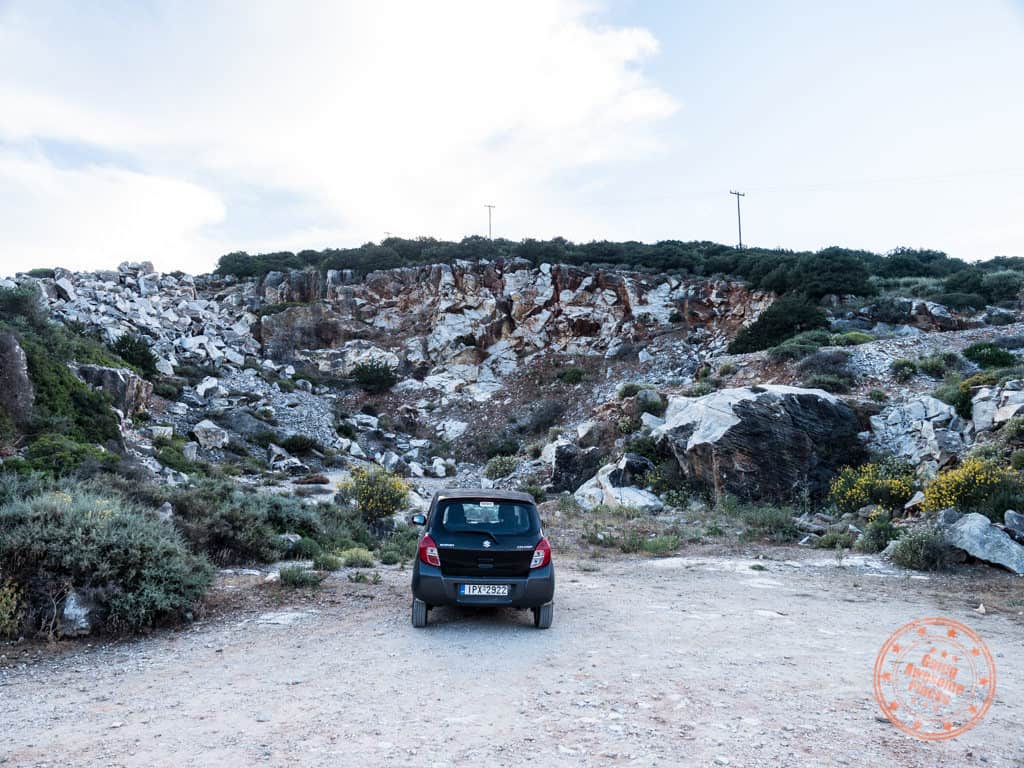
The tried and true method of getting around the island. Car rental companies are everywhere and the process to rent them is simple.
Depending on your requirements (having a larger group of people, moving luggage, comfort, experience, etc.), the car may be your only choice. With a car, you know what you’re getting and on most islands, all the places you’ll go are paved so there’s no issues getting around.
If Santorini is in your plans, check out this guide on where and how to rent a car in Santorini.
Pro: Fits more than 2 people, protects from the sun, stays cool with air condition, spacious and can transport more things.
Con: May not be as capable, or even possible, when it comes to off-road, uses slightly more gas and is less exciting than the alternative of an ATV. If you’re staying in old town areas the roads may not be accessible for cars.
Tips:
- You need an international driver’s license. This is an absolute must so don’t forget to get one from CAA or AAA (if you’re from North America) before you go.
- Ask about car insurance and know your coverage options.
- When renting a car, make sure to ask for your transmission of preference because they will assume manual if you don’t say anything.
- Ask for recommendations on how much gasoline you should fill in the tank based on where you’re going and how many days.
- Most cars you will rent in Greece are never full so there’s always the worry about whether you’ll have enough and how much to fill off the bat. You will need a lot less than you think. As an example, in Paros we filled up to the max from 3 ticks down on the gauge and after 2 days we barely used one tick. Filling up 48 EUR was a big mistake because 10 EUR would’ve been enough.
- What you see listed by a car rental company isn’t always the price they offer. There’s always an element of negotiation or they would just offer up automatic discounts. Yes, this may have been because we were in Greece during low-season but never be shy about asking for a discount. The fluidity of the price is why some car rental companies didn’t even allow me to take photos of their pricing sheet.
- Discounts can only be had if you pay by cash.
- During low season, reservations don’t seem to be necessary but would recommend it during high season.
- With a car, you can take advantage of the extra storage by loading up on supplies at the grocery store.
- You might not need the car every day so plan your itinerary in a way where you only need it for a grouping of days to save money.
- Think about whether it makes sense to rent from the port or not. It’s advantageous for those wanting a round trip rental from the point you get off the ferry to when you need to get on it again. Alternatively, some car rental companies allow you to pick up a car from one place and drop it off at the port. These are called one-way rentals and some have a minimal charge for it and others might add a significant fee.
ATV
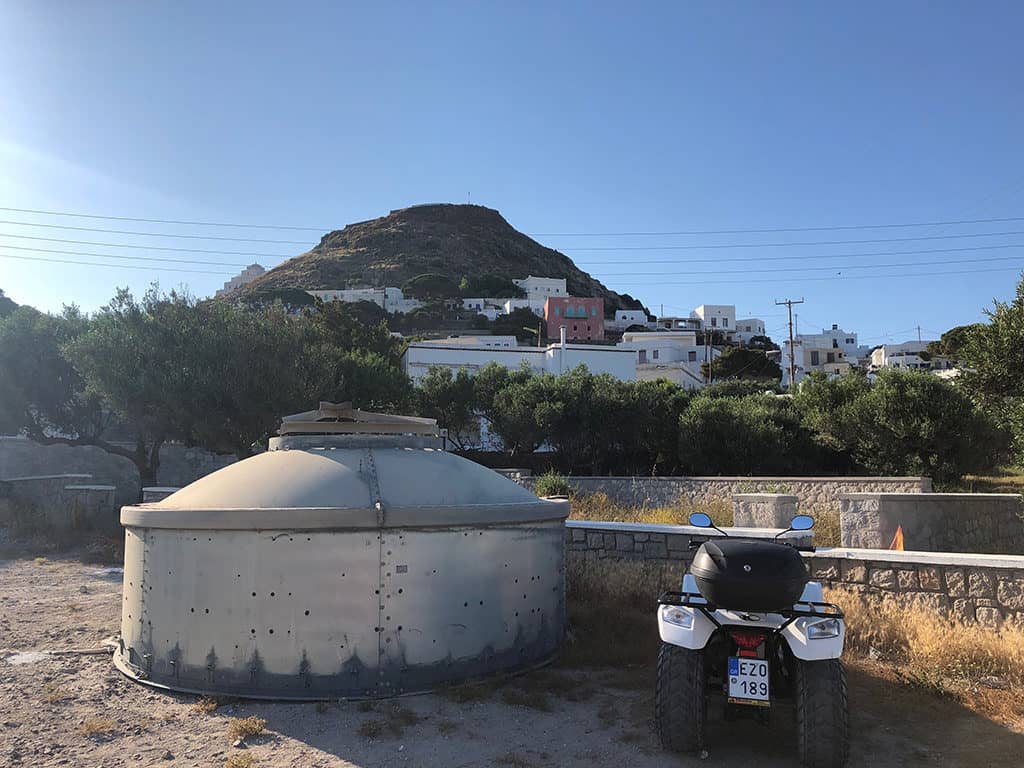
We don’t know any other place in the world where ATVs are this prevalent but it’s totally a “thing” on the Greek Islands. You’ll see them everywhere and be tempted to try it.
If there are two of you, and at least one is comfortable with driving an ATV, it’s a fun way to get around any island. They are incredibly handy when it comes to going off-road and in tight spaces because they are much smaller and more capable of handling all types of terrain.
The disadvantage is storage space. You’ll need to make sure your items can be strapped onto the vehicle or fit inside the storage compartment. We had lots of camera gear and things were tight but we managed to fit it.
If you’re not totally confident in driving an ATV on your own but still want to try the thrill of it, try this guided ATV tour through Santorini to get the hang of it while enjoying sights, local foods and wines along the way
We recommend trying the ATV on an island that has less traffic and large roads, such as Santorini, Milos or Paros, so you can get comfortable with driving around, especially if it’s your first time.
Pros: Off-road capabilities, great on tight turns (a factor in Milos), uses less gasoline and loads of fun!
Cons: Minimal storage space, no cover from the sun, learning curve to learn how to drive, not as safe as a car and no AC.
WHAT YOU NEED TO KNOW
ATV Travel Tips:
- You need an international driver’s license!
- Ask about insurance and know your coverage.
- Test the ATV and make sure that brakes work well before you leave the lot.
- Ask for a bungee cord if one isn’t provided to strap things to the front of the ATV.
- Similar to the car, most rental companies will offer discounts, especially during low season.
- Discounts can only be had if you pay by cash.
- The rear passenger on the ATV will be responsible for navigating by your phone’s GPS.
- Bring a sun hat and plenty of sun protection if you are visiting in the summer months. It is really easy to burn while cruising around in your ATV and you won’t feel it until you stop.
FAQ:
- Are ATVs easy to drive? It’s quite easy to drive because it’s automatic. You’ll just have to get used to making sure you hold the brake handle down when changing from Park to Drive and getting out of the habit of having your right foot rest on the secondary brake.
- Do you need more power than 170CC? We drove all over the island with our 170CC ATV and had no issues when off-road and climbing hills.
- How much fuel should I fill up for 2 days? On an island like Folegandros, we only used a fifth tank of fuel in two days.
Local buses

Every island has their own bus system – some better than others. It’s an economical option and possible to travel exclusively by bus.
The challenge you’ll face is you’ll be at the whim of their schedules and routes. It’ll get you to most places but some spots on the island you won’t reach.
Cost of the bus ranges from island to island but we’ve only seen it go as high as 3 EUR.
Where the bus works really well is in Santorini. There are multiple routes, they’re comfortable coach buses and they only cost 1.80 EUR.
Pros: Prices and one of the few options for those who don’t have a driver’s license.
Cons: Most buses don’t run 24/7, you are limited to their route schedule.
WHAT YOU NEED TO KNOW
Bus Travel Tips:
- Cash only. Try to have smaller change or notes available.
- Payment is taken on the bus. You either pay the driver or the ticket attendant who goes around once the bus starts moving.
Taxi
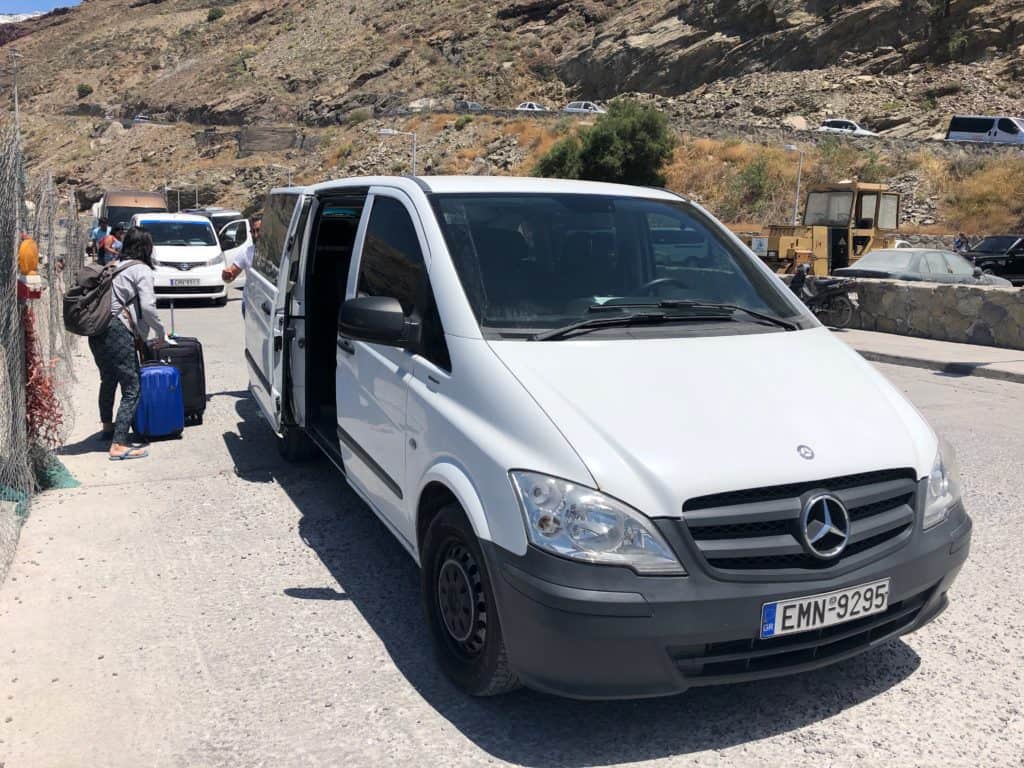
Taxis are the least cost effective way of getting around but may be necessary sometimes. Where it makes sense to take a taxi is when needing transport from your airport or ferry port to your hotel and you’re not renting a car right away.
Taxis work just like every other country. They normally run on a fixed fare system but we didn’t find this to be consistent. In most cases, you’ll hop in one and hope for the best. If you read any of our individual island guides, you’ll see we’ve shared some of the rates we paid but keep in mind that rates can change over time so don’t take our rates as the set price for you to expect. Use them as a rough guideline.
There was no Uber coverage anywhere. This may change in the future but we wouldn’t plan on using Uber on the islands.
Pros: Door to door service and convenience.
Cons: Expensive, at the mercy of their rates, may require some pre-planning in terms of booking particularly in less built-up places.
WHAT YOU NEED TO KNOW
Taxi Travel Tips:
- In some instances, it’ll be smart to book a shuttle service in advance. This can be done through your hotel or online. You can save money and you won’t have to deal with the chaos that ensues when you arrive. We find that GetYourGuide has plenty of shuttle service options for most of the destinations you will arrive at on your Greek island trip.
Where to book your hotels, car rental, ferries, flights, activities
- Hotels – Booking.com has the best inventory of properties and with their Genius tier, you can save even more money.
- Car Rental – If you’ve read our guide, you can book with the big brands combined with car rental coupon codes or you can use RentalCars to do a search of most companies. Make sure to also read the guide on how to rent a car in Santorini.
- Ferries – My go-to booking platform is FerryHopper.
- Flights – Use Skyscanner to look for cheap flights using the Everywhere feature and also setting price alerts.
- Activities – Always compare between Viator and GetYourGuide to get the best price.
Where to stay in the Greek Islands
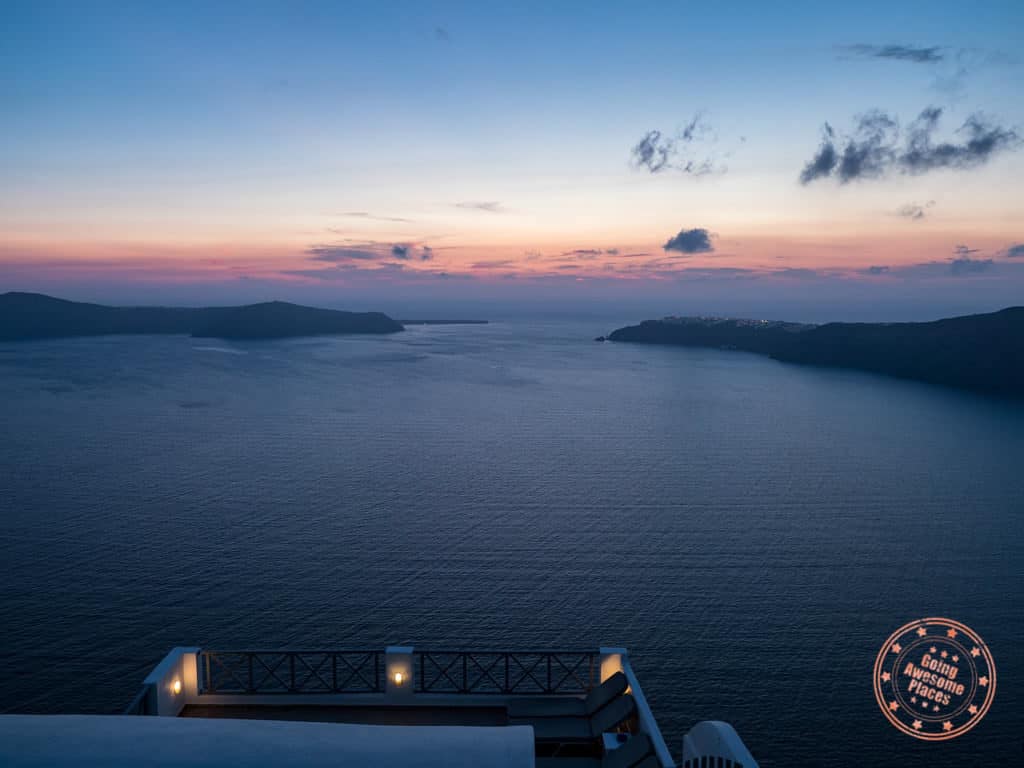
Depending on the island, you’ll have too many choices (Santorini, Mykonos, Milos), few choices (Folegandros, Sifnos, Serifos), or somewhere in between (Naxos, Paros).
Where You Should Stay in Santorini?
Where is the best area in Santorini to stay? Is Fira and Oia worth it? Read on to find out an honest look at each of the major towns and why you should consider each.
Instead of specific recommendations in this Greek Islands travel guide, we’ll share what we learned from planning our island hopping trip:
- Large chain hotels aren’t easy to find on the Greek Islands. Santorini and Crete are the exceptions. Everywhere else will be family-run hotels, villas, guest homes, B&Bs and budget-friendly hostels.
- There are Airbnb properties but many are the same listings you’ll find on Booking.com. We recommend Booking.com over Airbnb because there are better cancellation policies.
- We use Booking.com to book all of our accommodations. Getting up to Genius level only requires 2 bookings. Once you’re at that level many properties offer 10% (level 1 Genius) and 15% off (level 2 Genius).
- Book at least 8-12 months in advance in busier islands such as Santorini if you want something that has a view.
- For accommodation recommendations read our individual guides for each island we visited (Paros, Santorini, Folegandros, and Milos).
What to pack

Traveling to the Greek Islands doesn’t require a highly technical packing list.
A few things to consider specific to the Greek Islands:
- Beach towels – accommodation owners don’t like when guests use their towels at the beach. Ask for a beach-friendly one or pack your own.
- International Driver’s License – Hopefully we’ve got this drilled into your head. Make sure to get one before you go.
- Sunscreen – You can buy this there if you want to save on packing space. Between two people over 14 days, we’d recommend two full-sized bottles.
- Sunglasses – An obvious one, don’t forget these!
- Non-drowsy Gravol – If you get motion sickness pack this.
- Exchange Euros – It’s always a good idea to have Euros with you immediately after you land. Don’t leave the airport without at least some Euros otherwise you might find yourself scrambling around to find exchange offices and be at the mercy of their rates.
- Europe plug adapters – Easy to forget but make sure to have a few with you.
- Bring layers – Whether it be on the ferries or windy up on the caldera of Santorini, you never know when you might need that extra layer.
When to visit the Greek Islands

Low-season (November – March)
Let’s start with when not to go to the Greek Islands. Winters are pretty mild compared to other parts of Europe, but it’s quite variable with high chances of rain and dreary days.
In the low season the ferry and flight schedules are also reduced so your options are limited. Most of the islands are populated by seasonal workers, so you’ll have to contend with skeletal services, facilities and closures. Count on many hotels, restaurants, and activities (especially water-based ones) being closed.
The advantage is not many people travel to the islands in the winter so you won’t see many tourists. Things won’t be as lively as they normally are in other parts of the year, which if this is the kind of trip you are looking for, the low season is perfect.
Spring to Summer (April – Mid-June)
One of the best times to come. Flowers are blooming, the weather is warming and the large tourist hordes haven’t quite arrived yet.
Shoulder season means better prices and vacancies for hotels.
At this time of the year, flights and ferries switch to their full capacity schedule or close to it. Restaurants typically don’t need reservations and car rental companies are willing to offer additional discounts.
This applies even more for popular islands like Santorini. Make sure to read the best time to go to Santorini.
High-season (Mid-June – Mid-September)
This is the height of travel. Expect every aspect to be more challenging whether it’s hotels, car rentals, restaurants, ferries, flights or activities. You can also expect for prices to skyrocket for everything, this is the least economical time to travel and prices can get wild.
Not only are you contending with massive crowds, but the temperature is the hottest if that is a consideration for your trip to the Greek islands.
The only exception to this is in the north with islands like Samothraki and Thassos. They’re only super busy between July and August so you can get the summer heat with less of the volume of people. Some of the more popular islands are super busy and not as enjoyable in the summer so if tranquility is the aim of your trip add Mykonos, Crete, Kos, and Zakynthos to a list of Greek islands to avoid.
Summer to Fall (Mid-September – October)
The transition to Autumn is a great time to visit the Greek Islands. Similar to Spring, the weather is more temperate with the sea balmier than the air. Green lends its way to subtle Fall colors and that has its own beauty well worth experiencing while Greek island hopping.
How much does a trip to the Greek Islands cost?
If you’ve come from our Greek Island Hopping in the Western Cyclades itinerary, you’ll see the full breakdown of costs from that trip. Flights are excluded because they vary drastically from person to person depending on your starting point.
The category breakdown of our spending looked like this:

$2318.82/person or $165.63/person/day. Backpackers will look at this and say that’s too much and those looking for a luxury trip will think it’s too little. We’d say that we were pretty moderate when it came to making decisions on our trip.
Where we splurged:
- Getting a nicer hotel in Santorini
- Nicer dinners where it made sense
Where we saved money:
- Finding affordable properties outside of Santorini thanks to Booking.com.
- Avoided excursions and activities.
Cutting costs:
- Don’t rent a car/ATV – rely on buses or stay in an area where you can walk everywhere.
- Hop to fewer islands.
- Avoid big islands and focus on lesser-known ones.
- Find cheaper hostel accommodations through Hostelworld.
- Buy your own groceries to save money on meals where it makes sense (breakfast especially). There is something lovely about picking up pastries from a local bakery and enjoying it on a morning walk or sitting by the beach.
5 Main Takeaways

In short, this is what to know when planning a trip without reading this entire Greek Islands travel guide:
- You should have booked your Santorini hotel yesterday! This is the most popular island and gets booked up fast.
- Pick a good balance of popular and small islands – don’t be afraid to try the unknown ones like Folegandros.
- Always break change – you never know when you’ll need it.
- Fill no more than 5 EUR at a time with your car rental or ATV.
- It’s easy to let your guard down when you go back to Athens after spending time in the Greek Islands. Stay vigilant and beware of pick-pocketers immediately (read my story in the Athens 2 day itinerary).
Frequently Asked Questions
Santorini is the safest Greek Island to travel to, as it is one of the more popular islands, so there are always other tourists around. Here, locals are known to be very friendly and helpful to tourists, crime rates are low, and the transportation systems are highly rated as being reliable and safe to use.
The more affordable islands are Crete, Andros, Tinos, Corfu and Naxos, as they are less popular islands than some of the other well-known. Therefore, they are less travelled so prices on these islands are much cheaper than ones like Santorini.
Well you read this guide of course! Ultimately it depends on the type of experience you are looking for and the amount of time you are working with. For instance, if you don’t have much time during your travels the Saronic Islands are recommended since they are all close to Athens. If you are looking for the islands with the best nightlife, the Cyclades are for you. If you’re a foodie, you want to visit Crete! All islands offer something unique, so determining your visit will be unique to you!
Have specific questions about your upcoming trip to the Greek Islands? Drop a comment below in this Greek Islands travel guide!
What you should read next
Travel Resources For Your Next Trip
If you’re in the process of planning your trip and putting together your itinerary, these are genuinely the best resources that the Going Awesome Places team stands by 100%.
Credit cards: Don’t get burned by hidden fees on top of terrible exchange rates. When we travel now, we use the Wise Card. Simply load it with the currency you need before you go and use it as a regular VISA or their digital wallet card. Use their free app to track how much you have and top up when you need to.
Flights: Of all the booking search engines, Skyscanner is the most helpful and easy to use thanks to their Everywhere feature. Kayak is also another that’s we will often check as well.
Car Rental: If you’re looking to save money, these car rental coupon codes will be a true game-changer. Otherwise, DiscoverCars and RentalCars are great places to start.
Airport Parking: You’ll need a spot to leave your car at the airport so why not book a spot at a discount. Use code AWESOME7 to get at least $5 off at Airport Parking Reservations or Park Sleep Fly packages.
Data: We’ve been a huge fan of wifi hotspot devices like PokeFi because their rates are so good and you can use it globally but recently, we’ve really loved using eSIMs. The best one is Airalo. Save money by getting region-specific eSIMs and use referral code WILLIA9500 to get $3 USD credit on your first purchase. Ubigi is another one that we’ve had success with where they uniquely offer 5G coverage. Use code AWESOME10 to save 10% on your first order.
Hotels: Our go-to is Booking.com because they have the best inventory of properties including hotels and B&Bs plus they have their Genius tier discounts. The exception is Asia where Agoda always has the best prices. TripAdvisor is also useful for reviews and bookings.
Vacation Rentals: Your first instinct will be to check Airbnb but we always recommend checking VRBO as well if you’re looking for a vacation rental.
Tours: When planning our trips, we always check both Viator and GetYourGuide to at least see what’s out there in the destination that we’re going to. They often have different offerings and prices so check both.
Travel Insurance: Learn how to buy the best travel insurance for you. This isn’t something you want to travel without.
- Insured Nomads – Popular insurance provider for frequent travelers and comes with great coverage and special perks.
- RATESDOTCA – Search engine Canadians looking for the cheapest insurance including multi-trip annual policies.
- SafetyWing – A perfect fit for long-term nomads.
- Medjet – Global air medical transportation.
- InsureMyTrip – Best for seniors, families, and those with pre-existing conditions.
If you need more help planning your trip, make sure to check out our Travel Toolbox where we highlight all of the gear, resources, and tools we use when traveling.






